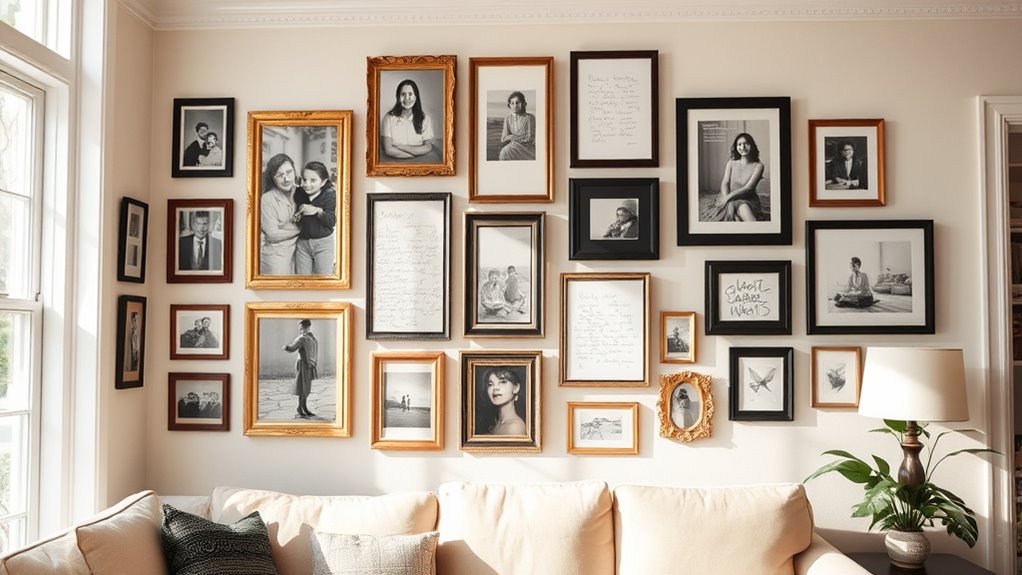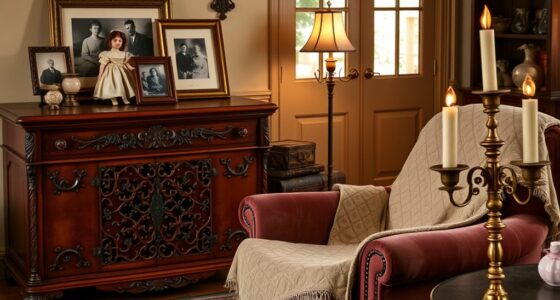To create a gallery wall with meaning, start by planning your layout using paper templates or digital tools to arrange artwork and objects thoughtfully. Choose meaningful photos, art, and personal items that reflect your story and style, mixing media for depth. Incorporate different frames and 3D elements to add visual interest. Arrange everything with balance and intention, then hang with care. Keep it fresh by updating over time—exploring these tips can help you craft a truly personalized display.
Key Takeaways
- Select meaningful artwork, photos, and objects that tell a personal story or evoke emotion.
- Plan your layout using templates, floor arrangements, or digital mock-ups to visualize spacing and balance.
- Mix styles, media, and textured elements to add depth and authenticity to your gallery wall.
- Maintain consistent spacing and balance, grouping similar styles or colors for cohesion.
- Regularly update and reconfigure the display to reflect evolving interests and keep it fresh.
Planning Your Gallery Wall Layout and Composition
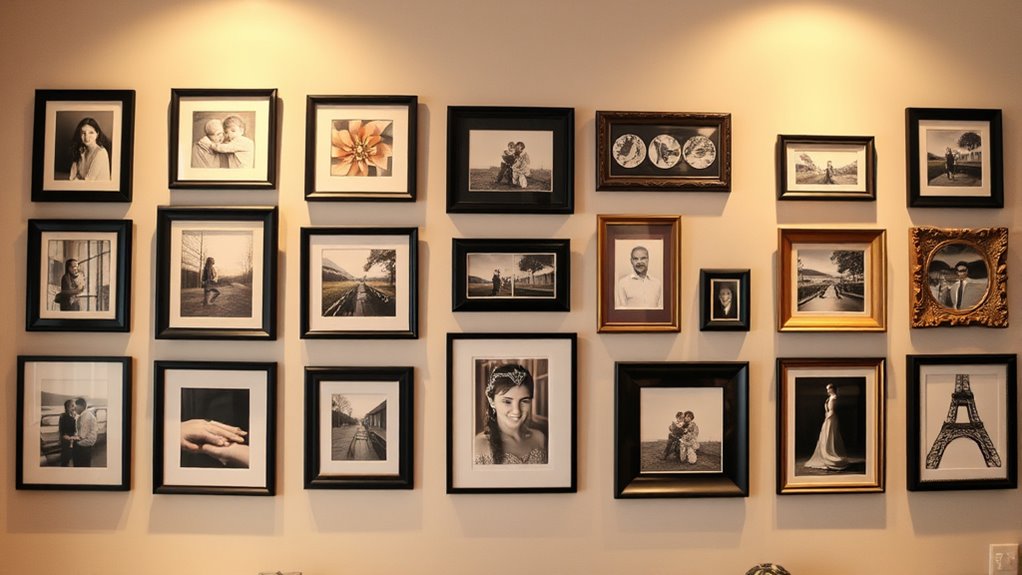
Before hanging your gallery wall, it’s vital to plan the layout carefully. Start by measuring and marking the wall space with tape or paper templates to visualize the arrangement.
Planning your gallery wall layout with precise measurements ensures a cohesive and visually pleasing display.
Arrange all artwork on the floor or a large table, placing the largest pieces as anchors and building outward. Maintain consistent spacing, ideally 2 to 4 inches between frames, to create a balanced composition. Incorporating visual hierarchy can help emphasize certain pieces and guide the viewer’s eye through the display. Creating a cohesive theme can also unify the diverse pieces and make the display more harmonious.
Mix different orientations and framing styles to add visual interest, but keep the overall style and theme in mind. Take photos of your floor or paper arrangements to reference during installation.
Additionally, consider the contrast ratio of your wall color and artwork to ensure that each piece stands out and contributes to the overall aesthetic. A well-balanced composition will help you achieve a cohesive and appealing gallery wall, with a well-thought-out layout that highlights each piece’s contribution to the overall visual interest. Incorporating artwork diversity can further enhance the visual appeal and storytelling aspect of your gallery wall.
Choosing Art, Photos, and Personal Objects With Purpose

When selecting art, photos, and objects for your gallery wall, choose pieces that truly resonate with you or tell an important story.
Mix different styles and media, like vintage posters or handmade items, to add depth and authenticity.
Focus on quality and emotional meaning to make each piece intentionally contribute to your space.
Meaningful Art Selection
How do you choose artwork, photos, and objects that truly resonate with you? Start by selecting meaningful art that tells your story or sparks emotion. Look for art pieces that fit your style and feel authentic. Use frames that enhance each piece’s significance, whether wide mats for photos or shadow boxes for memorabilia. Incorporate ethical hacking principles into your selection process by assessing the security and authenticity of any digital or sensitive items you include. When you create a gallery wall, aim for a balanced mix of media—family photos, travel souvenirs, handmade art—that adds depth and authenticity. Prioritize quality and emotional connection over quantity, ensuring each item serves a purpose.
A framing service can help you select the right frames to highlight your art. By intentionally choosing and framing your artwork, you build a cohesive display filled with personal meaning.
Personal Items With Purpose
Have you ever considered how personal items can transform a gallery wall into a meaningful narrative? By choosing family photos, sentimental memorabilia, or heirloom objects, you add authenticity and emotional depth. Select personal items that reflect your personality, memories, or cultural heritage for a curated display with personal significance. Purposefully include travel souvenirs, handmade crafts, or inherited pieces to tell a visual story about your life. Pair these objects with artwork that complements their colors or textures to create cohesion. Arranging personal items thoughtfully fosters a sense of connection and makes the display uniquely meaningful. Incorporating personal storytelling elements can also symbolize your interests and passions, further enriching your collection. Emphasizing cultural heritage can deepen the narrative, highlighting traditions and backgrounds that resonate with you. Being aware of display techniques can help you arrange these items in an aesthetically pleasing way that enhances their significance.
Selecting Frames and Incorporating 3D Elements for Visual Interest
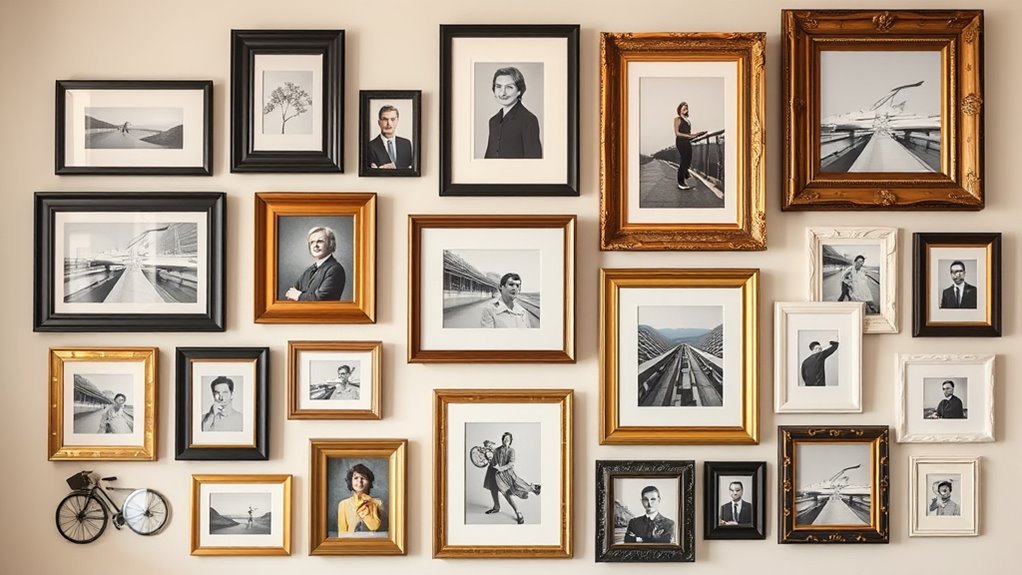
Choosing the right frames and adding 3D elements can dramatically enhance the visual interest of your gallery wall. Mix frame styles like wood, metal, and neutral tones to create an eclectic charm that keeps the eye moving. Incorporate textured decor, such as small sculptures or memorabilia, to add depth and break the flatness of traditional artwork. Float mounting items like tickets or textiles elevates their prominence and introduces a layered look. Use objects with contrasting shapes—round mirrors or textured ceramics—to introduce visual rhythm and variety. When selecting decor, guarantee it complements your overall style and color palette for seamless integration. Understanding visual hierarchy in design can help you arrange your objects to guide the viewer’s eye naturally across the display. Utilizing color coordination can further unify your gallery wall and enhance its aesthetic appeal. This thoughtful combination of mixed finishes, textures, and 3D elements transforms your gallery into a dynamic, engaging display that reflects your personality. Regularly assessing your arrangement ensures it remains balanced and organized, preventing clutter and maintaining visual interest. Additionally, considering interior decor principles can help you achieve a cohesive and inviting atmosphere in your space.
Arranging and Visualizing Your Gallery Before Hanging
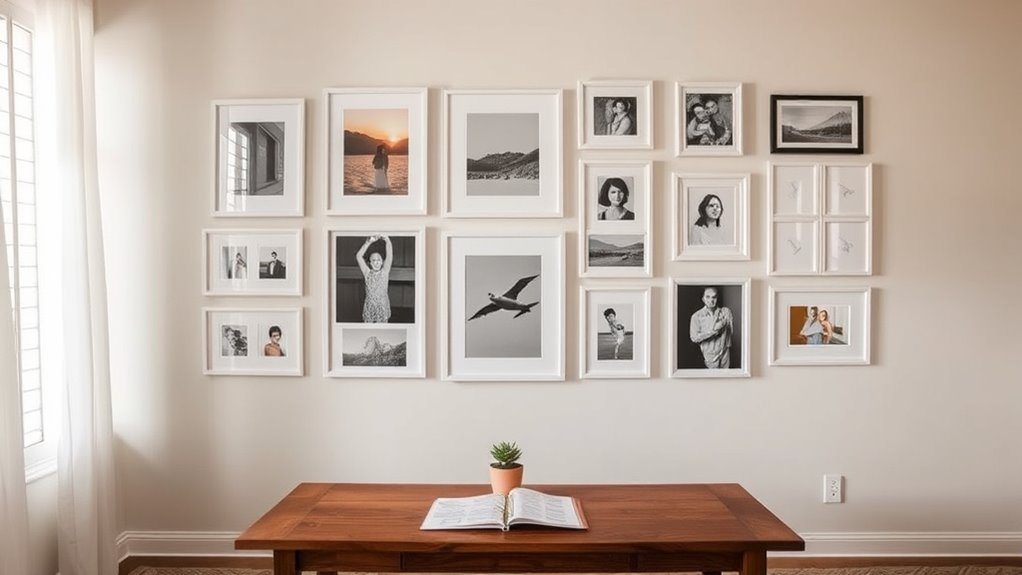
Before hanging your gallery, take time to plan and visualize your layout. Use measuring tools, painters’ tape, or full-size paper templates to experiment with spacing and placement.
Laying out your art on the floor or using digital tools helps guarantee a balanced and meaningful display.
Floor Planning Techniques
Wondering how to visualize your gallery wall before hanging? Start with floor planning by outlining your layout on the floor with painter’s tape. Use templates of your artwork, cut to scale, to experiment with spacing and arrangement. Begin with the largest or focal piece to create a balanced visual. Adjust spacing, typically 2-4 inches apart, to ensure harmony. Take photos of your floor layout from above for reference during installation. Grouping art by style, color, or size helps create cohesion. Incorporating automation in business concepts can inspire innovative display arrangements that streamline the process. Considering best practices for display can further enhance the visual appeal of your gallery. Use this table to compare different arrangements:
| Layout Option | Description |
|---|---|
| Symmetrical | Balanced, formal look |
| Asymmetrical | Dynamic, modern feel |
| Grid | Clean, uniform spacing |
This method helps you visualize and refine your gallery before hanging, especially when considering asset division to ensure your space reflects your personal story. Additionally, experimenting with different configurations can help you understand how visual weight impacts the overall aesthetic.
Digital Layout Tools
Digital layout tools like Illustrator, PowerPoint, Keynote, or Google Slides make it easy to create scaled mock-ups of your gallery wall without any physical effort. With these layout tools, you can visualize spacing and experiment with different arrangements, such as grid or eclectic styles, before committing to hanging.
They allow for precise resizing of artwork to match actual dimensions, helping you plan the perfect wall arrangement and determine how many pieces will fit. Using a digital mock-up helps identify potential spacing issues or overlaps early, saving time and preventing wall damage.
Many tools also offer pre-designed templates or wall arrangement ideas, inspiring your creativity and streamlining the planning process. Overall, digital layout tools bring clarity and confidence to your gallery wall setup.
Visual Balance Tips
Once you’ve created a digital mock-up of your gallery wall, it’s time to bring that vision to life. To achieve visual balance, start by outlining each art piece’s size on the wall with paper templates or painter’s tape. This helps you visualize spacing and overall layout before hanging. Incorporating a professional approach can ensure your arrangement looks polished and cohesive. A helpful tip is to consider the weight distribution of your artwork when arranging, as varying weights can impact the overall harmony of the display. Understanding cleaning and maintenance principles can also contribute to preserving the aesthetic integrity of your gallery over time. This awareness allows you to create a more dynamic and balanced composition. 1. Arrange artworks on the floor or a large table, experimenting with different layouts and distances to find a harmonious composition. 2. Hang larger or anchor pieces first, then build around them, distributing visual weight evenly for a balanced presentation. 3. Step back frequently, viewing from a distance or eye level, and adjust spacing and art arrangement as needed to create symmetry and a pleasing visual flow.
Techniques for Hanging and Positioning Your Artwork With Intention

To create a cohesive gallery wall that feels intentional, start by measuring and marking the desired height for your artwork—typically around eye level at 57-60 inches from the floor. Use painter’s tape or a paper template to outline your arrangement, helping you visualize spacing and composition before hanging. Hang larger, anchor pieces first, positioning them slightly off-center or in a corner to add visual interest and balance. Maintain consistent spacing of 2-3 inches, but vary slightly for a relaxed look. Use appropriate hardware rated for your art’s weight, and double-check alignment with a level for precise, intentional placement. This approach ensures your gallery wall feels thoughtfully curated and visually appealing. Incorporating varied textures and styles can further elevate your display and add depth to your arrangement. Additionally, considering the local environment, such as lighting and climate, can help preserve your artwork over time. Being mindful of art preservation techniques can also prolong the life of your gallery pieces.
Adding Personal Touches to Create a Cohesive Story
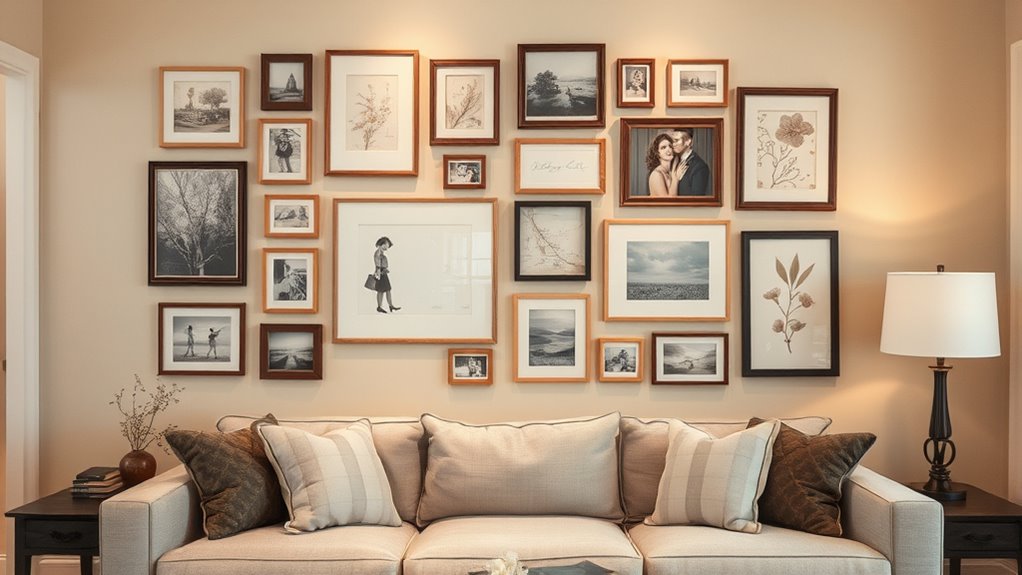
Adding personal touches to your gallery wall transforms it from a collection of art into a meaningful storytelling space. To create a cohesive story, focus on these key steps:
- Incorporate meaningful items like family photos, heirlooms, or souvenirs to personalize the display and highlight personal milestones.
- Use a consistent color palette or theme to unify diverse pieces and maintain visual harmony.
- Mix different media—such as photographs, handwritten notes, or small objects—to add depth and authenticity, while leaving space around cherished items emphasizes their significance.
Tips for Maintaining and Updating Your Gallery Over Time

Maintaining and updating your gallery wall guarantees it continues to reflect your evolving style and interests. Regularly review the arrangement to ensure it stays balanced and cohesive as you add or remove pieces.
Incorporate new artwork or meaningful objects over time to keep the display fresh and meaningful. Use versatile hanging solutions like removable strips or clips, making it easy to update or swap out items without damaging the wall.
Consider seasonal or themed updates, such as changing art for holidays, to add variety and engagement. Periodic assessment helps you identify pieces that no longer resonate and decide whether to replace or reconfigure them.
This ongoing process keeps your gallery dynamic, personal, and a true reflection of your current tastes and experiences.
Gathering Inspiration and Resources to Refine Your Gallery Wall

Gathering inspiration and resources is an essential step in refining your gallery wall, ensuring it reflects your unique style. To start, explore online platforms like Etsy, Desenio, and The Poster Club for art prints and unique pieces that add diversity and visual interest.
Next, visit local galleries, thrift shops, and antique stores to discover one-of-a-kind art and sentimental objects that bring character.
Lastly, gather ideas from home decor magazines, interior design blogs, and social media accounts focused on gallery wall inspiration.
Use digital tools like PowerPoint or Google Slides to experiment with your layout before hanging, helping you achieve a cohesive, personalized arrangement.
Collect a variety of frames, from vintage to modern, to enhance your gallery wall’s visual appeal and reflect your style.
Frequently Asked Questions
What Is the Rule for Gallery Walls?
The rule for gallery walls isn’t strict; it’s all about personal style. You can arrange your frames symmetrically, asymmetrically, or eclectic.
Keep about 2-4 inches between frames for balance, starting with a large anchor piece, then add smaller ones around it.
Mix frame styles and sizes for interest, but stay consistent with colors or themes.
Ultimately, do what feels visually pleasing and meaningful to you.
What Is the 2/3 Rule for Wall Art?
The 2/3 rule for wall art suggests that your artwork should cover about two-thirds of the furniture or wall space below or around it.
You aim for the combined width of your pieces to be roughly 66% of the surface they’re above.
This creates a balanced, cohesive look, preventing your gallery from feeling too small or overwhelming, and helps your arrangement look intentional and visually pleasing.
What Is the Purpose of a Gallery Wall?
Think of a gallery wall as a visual tapestry that tells your story. Its purpose is to transform a blank wall into a personal gallery, showcasing your style, memories, and passions.
Is There an App to Design a Gallery Wall?
Yes, there are apps that help you design a gallery wall. You can use tools like Canva, Roomstyler, or Morpholio Board to upload your images, measure your wall space, and create custom layouts.
These apps let you drag, resize, and rotate artwork to see how everything fits before hanging. They’re perfect for visualizing your ideal arrangement, saving you time and avoiding unnecessary holes in your wall.
Conclusion
As you step back to admire your gallery wall, imagine a vibrant tapestry of memories, passions, and stories woven together. Each piece, frame, and object reflects your unique journey, turning your wall into a mesmerizing visual narrative. With thoughtful planning and personal touches, your space becomes a dynamic canvas of meaning and beauty. Keep updating and refining it, and watch as your wall continues to tell your story, inspiring everyone who enters your home.
